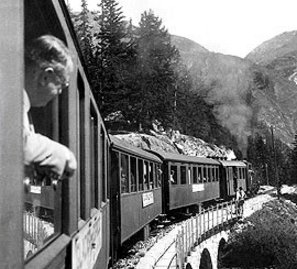
What was once an eleven-hour trip can now be made in just seven and a half travelling in the legendary Glacier Express from St. Moritz to Zermatt or vice versa. The Alpine train is operated by the Matterhorn Gotthard Bahn and the Rhaetian Railway. The trip on “the slowest express train in the world” – one of the nicknames of the Glacier Express – takes passengers over 291 bridges, through 91 tunnels and up the 2033-metre-high Oberalp Pass. Tunnels lead through two further passes (Albula and Furka).

Nostalgic beginnings
By the golden age of the 1920s, well-to-do society from Switzerland and all over the world had already discovered the charms of the Swiss Alps. Once isolated mountain villages such as Zermatt and St. Moritz were transformed into cosmopolitan resort towns. Initially, however, the entire route was only in operation for four months in the summer, and it would take more than 50 years before the Glacier Express would be able to run in the winter as well. Before construction began on the Furka Base Tunnel in June 1982 (which enables the Glacier Express to operate year-round today), the route passed through the Scheitel Tunnel at 2162 metres, which offered a view of the Rhone Glacier.
The panoramic trip was made in parlour cars and passenger cars with three different classes of service. Whereas the BVZ Zermatt-Bahn (still known as the Visp-Zermatt-Bahn at the time) and the Rhaetian Railway were already electrified, the Furka Oberalp Bahn still used steam-powered locomotives on its lines until August 1942. Thereafter, the Glacier Express was powered by electricity only.

More comfort and shorter travel times
Service on the Glacier Express was halted during World War II. However, the train was back on the rails in 1948, with certain changes implemented. The elegant parlour cars were discontinued, but the dining car was open for service all the way to the Oberalp Pass. The Glacier Express also benefited from the technological progress made in the 1950s and 1960s and the resulting development of railway traction vehicles. The slowest express train in the world offered shorter travel times, more comfortable coaches and a dining car available all the way to Andermatt.

Premium tourism product
Thanks to cutting-edge technology and targeted marketing measures, the Glacier Express transformed itself into a distinctive first-class Swiss tourism product in the 1980s and 1990s. Worldwide demand for the Swiss Alpine train continues undiminished. This success is due not only to extensive investments in infrastructure – e.g. contemporary coach materials and climate-controlled panoramic cars – but also to exclusive highlights such as impeccable dining service, unique special journeys and a wide array of package offers.





